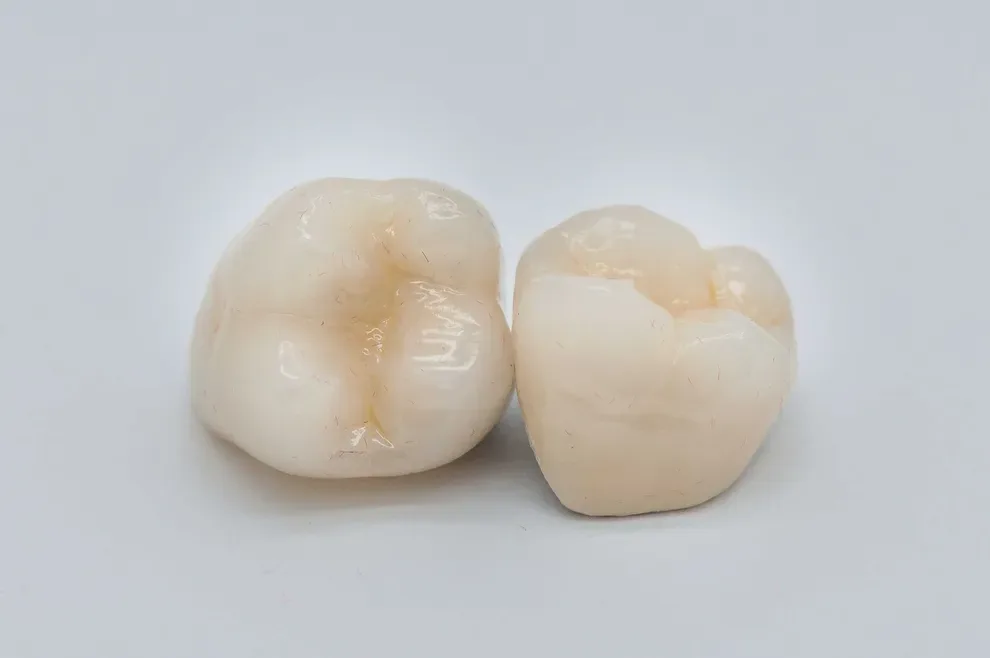Tooth Cap & Dental Crown: What Are They & When Do You Need One?

Table of Contents
- What is a Tooth Cap or Crown?
- When Are They Needed?
- Materials Used for Tooth Caps
- Tooth Cap Procedure
- Same-Day Tooth Caps
- Tooth Cap Care
- Tooth Caps Cost
- References
Damage or injury to a tooth is sometimes too severe to be treated with a filling or standard repair. Or you may need a dental procedure that requires the stability of a tooth stronger than your natural one.
In these instances, a dentist might recommend a tooth cap — also known as a dental crown — in order to save, improve, or protect your bite and smile.
The idea of “replacing” your tooth with a cap may seem scary, but tooth caps or crowns are very common. Thanks to numbing agents and modern technology, the procedure is relatively pain-free and easy. Most people end up very happy with how their smile looks and feels after getting a tooth cap or dental crown.
You can choose a material that will make your cap blend in with the rest of your teeth. Once placed, your cap requires no special care and should last years. You simply treat it like your natural teeth.
What is a tooth cap or dental crown?
A tooth cap, or dental crown, is a prosthetic (artificial) tooth designed to cover a damaged or modified tooth. Tooth caps are placed over an existing tooth and set in a fixed position. They are most commonly tooth-colored.
Tooth caps can improve the overall appearance of a tooth by covering damage or staining. They can also provide stability to a tooth that has been weakened by damage or decay.
When is a tooth cap or dental crown needed?
There are many circumstances in which a dentist might recommend tooth caps, including these:
To protect a weak or cracked tooth from further breaking
To restore a seriously damaged or decayed tooth
To provide support to a tooth with a large filling and not much natural tooth left
To support the placement of a dental bridge
To improve the appearance of a discolored or misshapen tooth
To go over a dental implant
To provide coverage to a tooth after root canal treatment
What Materials Are Used for Tooth Caps?
These are the most commonly used materials for tooth caps:
Because of their metallic appearance, metal is not a top choice for many who are looking for an aesthetically pleasing crown in a visible spot. However, metal is very durable and therefore still popular for use in less visible teeth, like back molars.
Dentists may use palladium, nickel, and chromium. Gold can also be used and is sometimes chosen as a fashion statement, although most of the gold caps and “grillz” worn in popular style are removable.
Using porcelain fused to metal, these tooth caps are designed to match tooth color while maintaining some of the durability provided by the metal core. However, the porcelain can become damaged or worn down and reveal the metal underneath.
Tooth caps made from all resin are usually less expensive than those made of other materials. However, they generally don’t last as long and may be prone to breakage.
Because they offer the best appearance (matching to other teeth), these types of tooth caps are a top pick for front teeth. They’re also an option for those with metal allergies or sensitivities.
But they do have a few disadvantages. They’re not as strong when not fused to metal, and they can wear on nearby teeth more than other materials.
A pressed ceramic hard inner core gives these caps improved durability over all-ceramic or all-porcelain options, while the porcelain cap provides excellent tooth-matching ability.
What is the procedure for putting on a tooth cap?
Most often, the procedure for a tooth cap or dental crown will take two visits to the dentist. However, this depends on the complexity of the tooth problem as well as your dentist and the type of technology available in the office.
Here are the common steps involved in the procedure for getting a tooth cap:
Visit 1: examination & preparation
The tooth that will be receiving a crown is examined. X-rays are taken to assess the severity of the problem.
Depending on the tooth’s condition, a decision will be made whether to perform a root canal on it. If there is decay, there is a possibility of infection or damage/injury to the tooth’s pulp (the soft tissue inside of teeth that contains tissue, blood vessels, and nerves). The dentist will likely recommend a root canal, which is a procedure to remove inflamed pulp from a tooth and then clean and seal the space to prevent infection or further problems.
The tooth is filed down to make space for the crown. The amount of filing required will depend on the material being used for the cap. Metal caps won’t require as much filing. If there isn’t enough tooth to provide structure for the crown (due to damage or decay), filling material will be used to build the tooth structure.
A paste or putty is used to make an impression of the tooth that’s receiving the crown, as well as the surrounding teeth, to ensure that the crown will fit the tooth well and not affect the bite or create misalignment. These impressions are usually sent out to a lab to create and return your permanent tooth cap. This can take a few weeks.
The dentist will give you a temporary crown to cover the tooth until the permanent crown is placed.
Visit 2: the permanent crown
The temporary crown is removed.
The permanent crown is checked for proper fit and color.
A local anesthetic may be applied to numb the tooth.
The permanent crown is cemented to the tooth.
New technology: same-day tooth caps
Today, some dental offices also offer same-day tooth caps using CAD (computer-aided design) or CAM (computer-aided manufacturing). The procedure for same-day tooth caps is the same as the above until the tooth is filed down and shaped for a cap. However, instead of a temporary crown being placed, the following happens:
A scan is taken of the teeth with a device or wand. This device takes pictures of the tooth and bite.
Advanced software makes a 3D design model of the tooth from the device’s pictures.
An in-office machine creates the actual crown from a block of ceramic or other materials.
The permanent crown could be ready in as little as 15 minutes. It can then be placed on the tooth.
How do you care for a tooth cap?
Permanent tooth caps don’t require additional daily care, but the tooth under the cap is still vulnerable to decay and gum disease, so good dental hygiene is important in preventing future problems.
A good dental hygiene routine for tooth caps should include the following steps:
Brush teeth twice daily.
Floss once a day.
When flossing, focus on the crown area and the gumline.
Use an antiseptic mouthwash.
In addition to practicing good dental hygiene, avoid these activities and habits to prevent damage to tooth caps and help them last longer:
Tooth grinding
Biting into hard foods or chewing on ice
Nail biting
Opening packages or bags with your teeth
Smoking
How much do tooth caps cost?
The cost of tooth caps will vary depending on a number of factors, including where you live, what type of materials you choose for your caps, and how complicated the underlying dental problem you’re experiencing is (such as, if you need a root canal or additional filling).
Generally, the fee for a single permanent tooth cap will range from $800 to $1,500 or more. Some dental insurance companies may provide coverage for some or all of the cost.
There is no difference between a tooth cap and dental crown. They are just different terms used for the same thing. Today, most dentists use the term crown rather than tooth cap.
Tooth caps generally last at least 7 years, but usually much longer. In some cases, a crown can last up to 40 years.
The procedure for getting a tooth cap should be relatively painless with the use of numbing anesthesia or mild sedation. If a root canal was part of the procedure, some discomfort or sensitivity may be experienced. Your dentist may advise the use of an over-the-counter pain reliever or prescribe a stronger medication if needed.
